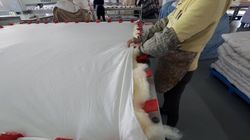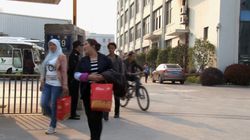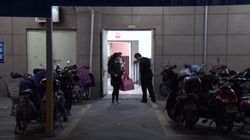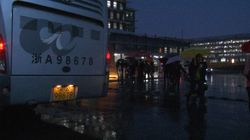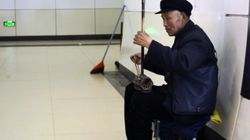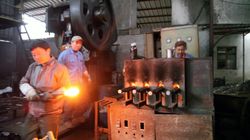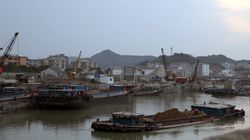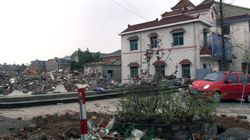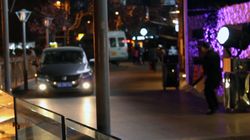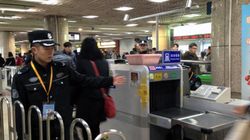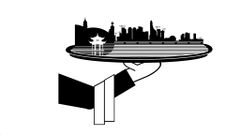Hangzhou|China
Statistische Daten
Google-Einträge für Hangzhou und 杭州 190.600.000
Google-Einträge pro Einwohner (Stadtgebiet) 30,53
Erste schriftliche Erwähnung (als „Yuhang“) 220 v. C.
http://en.wikipedia.org/wiki/Hangzhou
Fläche
Stadtgebiet 3.372 km²
Sub-provincial city 16.847 km²
Metropolregion 34.585 km²
http://en.wikipedia.org/wiki/Hangzhou
BEVÖLKERUNG (2012)
Stadtgebiet 6,24 Mio.
Sub-provincial city 8,80 Mio.
Metropolregion 21,10 Mio.
http://en.wikipedia.org/wiki/Hangzhou
Bevölkerungsdichte (Einwohner / km²)
Stadtgebiet 1.851
Metropolregion 610
Altersstruktur (2008)
0 – 14 987.800
15 – 64 6.109.910
65 + 868.300
http://eng.hangzhou.gov.cn/main/zpd/English/AboutHangZhou/T305817.shtml
KLIMA
Max. Temperatur Ø (°C) 20,7
Min. Temperatur Ø (°C) 12,9
Niederschlag / Jahr (mm) 1.376
Regentage 155
http://de.wikipedia.org/wiki/Hangzhou
WIRTSCHAFT
GDP 2008 66,95 Mrd. USD [1]
GDP 2013 136,11 Mrd. USD [2]
jährliche Wachstumsrate (2008 - 2012) 13,7% [1]
GDP Metropolgebiet (2011) 229.7 Mrd. USD [2]
GDP per Capita 2001 3.024 USD [3]
GDP per Capita 2013 15.467 USD [1]
[1] http://www.kpmg.com/CN/en/IssuesAndInsights/ArticlesPublications/Documents/Invest-Hangzhou-New-Energy-201305.pdf
[2] http://en.wikipedia.org/wiki/Hangzhou
[3] http://www.wtcsd.org/Resources/Documents/130730%20China%20TIPS.pdf
Anteile am GDP nach Sektoren (2012)
Primärer Sektor 3,3%
Sekundärer Sektor 46,5%
Tertiärer Sektor 50,2%
http://www.chinaknowledge.com/CityInfo/City.aspx?Region=Coastal&City=Hangzhou
Anteil der Privatwirtschaft am GDP (2012) 59,7%
http://www.hzstats.gov.cn/web/shownews.aspx?id=QaVQ6opv1uQ=
Wichtige Wirtschaftszweige (GDP in Euro)
Bio-chemische Industrie 1,86 Mrd. (2012) [1]
Neue Energien 2,93 Mrd. (2012) [2]
Finanzen und Versicherungen 8,52 Mrd. (2011) [3]
Freizeit und Tourismus 16,20 Mrd. (2012) [4]
Modern Equipment Manufacturing (z.B. Transport, IT,
Automatisierung, Energieversorgung) 54,57 Mrd. (2012) [5]
[1] http://www.kpmg.com/CN/en/IssuesAndInsights/ArticlesPublications/Documents/Invest-Hangzhou-Biochemical-industry-201305.pdf
[2] http://www.kpmg.com/CN/en/IssuesAndInsights/ArticlesPublications/Documents/Invest-Hangzhou-New-Energy-201305.pdf
[3] http://www.kpmg.com/CN/en/IssuesAndInsights/ArticlesPublications/Documents/Invest-Hangzhou-Financial-Service-Industry-201209.pdf
[4] http://www.kpmg.com/CN/en/IssuesAndInsights/ArticlesPublications/Documents/Invest-Hangzhou-Tourism-and-leisure-201305.pdf
[5] http://www.kpmg.com/CN/en/IssuesAndInsights/ArticlesPublications/Documents/Invest-Hangzhou-Modern-equipment-manufacturing-201304.pdf
Ausländische Direktinvestitionen in Euro
2007 2,09 Mrd.
2009 3,02 Mrd.
2012 3,60 Mrd.
http://www.kpmg.com/CN/en/IssuesAndInsights/ArticlesPublications/Documents/Invest-Hangzhou-Modern-equipment-manufacturing-201304.pdf
TOURISMUS (2012)
inländische Touristen 82,37 Mio.
ausländische Touristen 13,31 Mio.
Umsatz 16,20 Mrd. Euro
http://www.chinaknowledge.com/CityInfo/City.aspx?Region=Coastal&City=Hangzhou
Sonderwirtschaftszonen (GDP in 2010 in Euro)
Hangzhou Economic & Technological Development Zone 4,18 Mrd.
Hangzhou Export Processing Zone 1,15 Mrd.
Hangzhou Hi-tech Industrial Development Zone 3,98 Mrd.
Hangzhou Xiaoshan Economic & Technological Development Zone 1,83 Mrd.
Hangzhou Zhijiang National Tourist & Holiday Resort N.A.
http://china-trade-research.hktdc.com/business-news/article/Fast-Facts/Hangzhou-Zhejiang-City-Information/ff/en/1/1X000000/1X09WA60.htm
Alibaba (privat geführte Gruppe von E-Commerce.Unternehmen mit Sitz in Hangzhou)
geschätzter Firmenwert 55 - 120 Mrd. USD
Angestellte (2012) 24.000
Das eBay-ähnliche Portal „Taobao“ gehört zu den 20 meistbesuchten Websites weltweit.
Handelsvolumen von Taobao (2012) mehr als 160 Mrd. USD
Zur Alibaba-Gruppe gehörende Sites verursachen mehr als 60% aller in China ausgelieferten Pakete.
http://en.wikipedia.org/wiki/Alibaba.com
ARBEIT
Arbeitsmarkt (China, 2012)
Gesamtbevölkerung 1,35 Mrd
Bevölkerung im arbeitsfähigen Alter (15-59) 937 Mio.
davon beschäftigt 767 Mio.
davon beschäftigt in städtischen Gebieten 371 Mio.
http://www.clb.org.hk/en/view-resource-centre-content/100060
Beschäftigte in städtischen Gebieten nach Art der Betriebsinhaberschaft (China, 2012)
Staatsbetriebe ca. 60 Mio.
Privatunternehmen ca. 69 Mio.
Ausländische Besitzer ca. 21 Mio.
Selbständige Einzelunternehmer ca. 52 Mio.
http://www.clb.org.hk/en/view-resource-centre-content/100060
Wanderarbeiter (China 2012)
Anzahl 262 Mio.
davon long distance 163 Mio.
Alter unter 30 ca. 40%
41 - 50 ca. 25%
über 50% ca. 15%
About 40 percent of migrant workers are under 30 years old. Factory bosses have traditionally sought younger workers to stand on the production line, believing they are more capable of performing long, tedious shifts, day in and day out. Moreover, young single workers can be housed in cheap, cramped dormitories on site that are unsuitable for older employees with children. However, the declining birthrate in China has meant that fewer young people are entering the workforce and those seeking jobs do not necessarily want to work in a factory. That has led to significant labour shortages in Guangdong and other coastal provinces, forcing employers to hire more workers in their 40s and 50s.
http://www.clb.org.hk/en/content/migrant-workers-and-their-children
Beschäftigung von Wanderarbeitern nach Sektoren (China 2012)
Produzierendes Gewerbe 35%
Baugewerbe 18%
Transport 6%
Handel 10%
Hotel- / Gaststättengewerbe 5%
Haushalts- und andere Dienstleistungen 12%
http://www.clb.org.hk/en/content/migrant-workers-and-their-children
Arbeitslosenquote (Hangzhou, 2012) 1,63%
http://china-trade-research.hktdc.com/business-news/article/Fast-Facts/Hangzhou-Zhejiang-City-Information/ff/en/1/1X000000/1X09WA60.htm
Jugendarbeitslosigkeit (China, 16-24 Jahre, 2012) 9,6%
http://www.cnbc.com/id/101433696?_ga=1.242392902.535194812.1397321319
Jugendarbeitslosigkeit nach Bildungsabschluss (China, 16-24 Jahre, 2012)
Primary education 4,2%
Junior High School 8,1%
Senior High 8,2%
Junior College 11,3%
University 16,4%
This observation is perhaps not that surprising; China’s economic miracle has insofar been driven by three sectors: export-driven manufacturing, construction and large energy and capital intensive heavy industries dominated by the state, none of which offer large number of white-collar jobs suitable for university graduates. By contrast, low-skilled workers with a primary and junior secondary education, especially young migrants from the rural China, can easily find jobs in the transportation, construction and catering industries. [...] need, currently these businesses are finding it tough to recruit and retain workers as demand is high and supply is low. This, in turn, has led to the continuing increase in wages.
http://www.cnbc.com/id/101433696?_ga=1.242392902.535194812.1397321319
Arbeitsmarktlage von Menschen mit höherer Bildung (China, 2013)
Graduierte insgesamt 6,9 Mio.
Graduierte in Peking 229.000
Jobs für Graduierte in Peking 98.000
One report on graduate employment showed that as of April 2013, only 32 percent of graduates from the higher vocational schools , 35 percent of those in undergraduate programmes and 26 percent of those in master programmes had secured employment, all these rates were at least ten percent lower than the figures in 2012. [...] Another survey in 2012 revealed that the monthly incomes of new graduates were basically comparable with those of migrant workers with a middle school education. The results showed that about 69 percent of graduates earned less than 2,000 yuan per month in their first job.
http://www.clb.org.hk/en/view-resource-centre-content/100060
Durchschnittliches verfügbares jährliches Einkommen (China, 2013)
Stadtbevölkerung 4.448 USD
Landbevölkerung 1.468 USD
http://www.bjreview.com.cn/nation/txt/2014-02/17/content_596909.htm
Durchschnittslohn (Hangzhou, 2013) 412,00 Euro
http://www.china-briefing.com/news/2013/11/19/average-wages-in-china-determining-minimum-and-maximum-social-insurance-contributions.html
Durchschnittslöhne im produzierenden Gewerbe (China)
2003 2.000 USD
2008 3.900 USD
2011 5.900 USD
http://qz.com/187350/six-charts-that-show-why-china-is-competing-with-the-multinationals-it-used-to-work-for/#/
Mindestlohn (Hangzhou Stadtgebiet, 2013)
Monat 241 USD
Stunde 1,97 USD
http://en.wikipedia.org/wiki/Minimum_wage_in_China
Lebenshaltungskosten
Preise (in EUR)
12 Eier 1,35,-
1 kg Tomaten 1,14,-
Brot für 2 Personen (1 Tag) 1,53,-
0,5 Liter Bier im Supermarkt 1,14,-
1 Liter Vollmilch 1,89
Stundenlohn Putzhilfe 2,56
Monatsmiete für eine möblierte 85 qm-Wohnung
in einem teuren Stadtviertel 599,00,-
1 Liter Benzin 0,87,-
Monatskarte ÖPNV 9,00,-
http://www.expatistan.com
VERKEHR
Kraftfahrzeuge
Zugelassene Fahrzeuge (2012) 2,4 Mio. [1]
durchschnittliche Steigerungsrate/Jahr (2007-2012) 190% [1]
Ausbau des Straßennetzes (2007-2012) 2% [1]
Durchschnittsgeschwindigkeit während Rush Hour weniger als 20 km/h [2]
[1] http://www.ha.xinhuanet.com/hnxw/2012-08/06/c_112631804_2.htm
[2] http://www.bloomberg.com/news/2014-03-26/hangzhou-joins-growing-list-of-china-cities-with-limits-on-cars.html
Luftqualität nach AQI (Air Qualty Index; 27.03.2014)
Durchschnittswert von 17 Messstationen 178
niedrigster Indexwert 165
höchster Indexwert 198
Erklärung des Indexes
Indexwerte zwischen 151 - 200 Unhealthy
Everyone may begin to experience health effects; members of sensitive groups may experience more serious health effects.
http://aqicn.org/map/hangzhou/
Limitierung der KFZ-Zulassungen
Neuzulassung (Februar 2013 bis Februar 2014) 276.000 [1]
Neuzulassungen nach Limitierung 80.000 [1]
davon Verteilung durch Verlosung 80% [1]
Verteilung durch Auktion 20% [1]
Anfangsgebot 1.628 USD [2]
[1] http://www.bloomberg.com/news/2014-03-26/hangzhou-joins-growing-list-of-china-cities-with-limits-on-cars.html
[2] http://usa.chinadaily.com.cn/china/2014-03/25/content_17378465.htm
ÖPNV
Metro
Eröffnung November 2012
Linien 1 (2 weitere im Bau)
Streckennetz 48km
Planung bis 2050 375km
Passagiere / Tag ca. 210.000
http://de.wikipedia.org/wiki/Hangzhou_Metro
BRT-System (Bus Rapid Transit)
Länge 55 km
Passagiere / Tag (2012) 260.000
http://brtdata.org/#/location/asia/china/hangzhou
Fahrräder
Hangzhou unterhält das weltweit größte öffentliche Fahrradprogramm mit 65.000 Fahrrädern.
http://www.wri.org/blog/trillion-rmb-question-how-can-china-fund-its-sustainable-urban-transport-growth
Beginn 2008
Servicestationen 2.674
Fahrräder 65.000
http://www.hzbus.com.cn/en/about.aspx?c_kind=706&c_kind2=707&c_kind3=1078
Anteil Fahrrad am ÖPNV
1997 60,8%
2000 42,8%
2007 33,5%
http://76.12.4.249/artman2/uploads/1/China___s_Hangzhou_Public_Bicycle.pdf
Modal Share (2009)
KFZ 13,7%
ÖPNV 19,7%
Nicht-motorisiert + E-Bikes 66,6%
http://www.unhabitat.org/downloads/docs/GRHS.2013.Case.Study.Hangzhou.China.pdf
Höhere Bildungseinrichtungen
38 Hochschulen und Universitäten mit jährlich 120.000 Graduierten.
http://www.kpmg.com/CN/en/IssuesAndInsights/ArticlesPublications/Documents/Invest-Hangzhou-Financial-Service-Industry-201209.pdf




